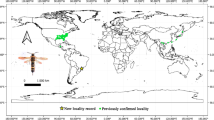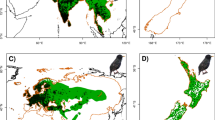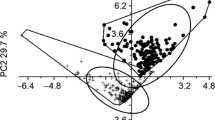Abstract
The non-native invasive anuran Lithobates catesbeianus is presently distributed in Brazil, especially in the Atlantic Rainforest biodiversity hotspot. Here, we use a maximum entropy ecological niche modeling algorithm (i) to model the North American native geographic distribution of this species and (ii) to project that model onto the whole of Brazil. After applying a threshold value that balances commission and omission errors, the projection results suggested high probabilities of occurrence mostly in southern and southeastern Brazil. We also present the first report on the species known distribution in Brazil, showing good agreement with model predictions. If the predictive map is interpreted as depicting invasiveness potential of L. catesbeianus, strategies to prevent further invasion in Brazil should be focused especially in the Atlantic Rainforest biodiversity hotspot.
Similar content being viewed by others
Avoid common mistakes on your manuscript.
Introduction
The American bullfrog (Lithobates catesbeianus Shaw 1802) has been considered one of the most harmful invasive species (Lowe et al. 2000). Native to eastern North America, from southern USA up to southern Canada, it was introduced, accidentally or intentionally, into southern Europe, Asia and South America (Bruening 2002). In Brazil, introductions have occurred since the 1930’s in association with aquaculture (Fontanello and Ferreira 2007). Presently the species is usually recorded in the field across several southern and southeastern localities (Borges-Martins et al. 2002), mostly in the Brazilian Atlantic Rainforest (Dixo and Verdade 2006; Conte and Rossa-Feres 2006). Whether this invasive species is or not contributing to population losses in some Brazilian native amphibians is unfortunately still a matter of speculation (Young et al. 2001; Silvano and Segalla 2005).
Ecological niche-modeling is a good tool to assess potential geographic distributions of species (Guisan and Thuiller 2005; Elith et al. 2006), providing in some cases additional information for conservation planning strategies and selection of protection areas (Jeganathan et al. 2004; Young 2007). Ecological niche modeling has also been applyed to the prediction of the invasive potential of non-native species (Peterson and Vieglais 2001; Peterson et al. 2003; Papes and Peterson 2003; Ficetola et al. 2007).
The potential global distribution of L. catesbeianus was recently predicted by Ficetola et al. (2007) but their work was mostly aimed at predicting the outcome of American bullfrog introductions (invasive or non-invasive) for well studied European non-native populations. We here wish to contrast their example with the rather poorly known non-native populations of L. catesbeianus in Brazil, which especially occur in the Atlantic Rainforest biodiversity hotspot. We use recently described ecological niche modeling methods to generate a predictive map for the distribution of L. catesbeianus in Brazil and compare our results with the available information for the actual Brazilian distribution of this frog.
Materials and methods
To produce an ecological niche model for the native distribution of L. catesbeianus we took 784 georeferenced occurrence points in North America from the Global Biodiversity Information Facility (2007) and HerpNet (2007) databases, including occurrences in Mexico, USA, and Canada (Fig. 1A). The data was checked in the DIVA-GIS software (Hijmans et al. 2002) for bias and errors.
(A) Predicted potential geographic distribution for Lithobates catesbeianus in North America resulting from Maxent climatic modeling using occurrence records within the species native range. The inset is the area of environmental calibration for the purpose of projecting the habitat suitabilility model (see text for details); (B) Projection map for the potential distribution of L. catesbeianus in Brazil. Real occurrence localities of the species in distinct Brazilian biomes are represented by distinct polygon shapes or shading (see legend in the figure)
We used 19 bioclimatic and 1 topographic layers as predictors. The bioclimatic variables result from global land area interpolation of climate point data (1950 – 2000 period) at a spatial resolution of 2.5 arc-min (Hijmans et al. 2005; available at http://www.worldclim.org). The altitude variable was derived from the U.S. Geological Survey’s Hydro-K data set, at the same spatial resolution.
The realized ecological niche was modeled using the Maxent software for species habitat modeling (MAXENT; Phillips et al. 2006, software available at http://www.cs.princeton.edu/∼schapire/maxent). It has been developed within the machine learning community and it implements a general purpose algorithm for making predictions and inferences from incomplete information. The MAXENT algorithm estimates geographic distributions of species from locality point data by finding the maximum entropy distribution (Phillips et al. 2006). MAXENT was ranked among the most effective methods for species distribution modeling from presence-only data in a recent comprehensive model comparison study (Elith et al. 2006).
The model was developed for occurrences within the native distribution in North America and run over the area represented by the inset in Fig. 1. Occurrence data were divided into training data, the 75% of occurrence point data that was used for model prediction, and test data, the 25% of occurrence point data that was used for model validation. The resulting model was evaluated with the Receiver Operating Characteristics Curve (ROC) calculating the area under the curve (AUC), a threshold independent index widely used in ecological studies. A ROC plot is created by plotting the sensitivity values, the true-positive fraction against 1-specificity, and the false positive fraction for all available probability thresholds (further reading: Fielding and Bell 1997, Manel et al. 2001). The AUC is a measure of the area under the ROC ranging from 0.5 (random accuracy) to a maximum value of 1.0 (perfect discrimination).
The output of MAXENT is a continuous map which allows fine distinctions to be made between the modeled suitability of different areas. To generate a binary (presence/absence) prediction map we used a cumulative threshold value that balances training omission, predicted area, and threshold value, i.e., balancing commission and omission errors (Phillips et al. 2006).
The resulting model was projected onto both North America and Brazil to assess the potential geographic distribution of L. catesbeianus. Probabilities below the threshold value were transformed to zero. Projection results for Brazil were validated only in areas where environmental conditions fall within the range of the calibration area, to avoid spurious projections (for details see Thuiller et al. 2004). Finally, we plotted the actual species occurrence points in Brazil (Appendix 1) on the predicted Brazilian distribution map.
Results and discussion
Invasive species are one of the most important threats to native communities (Begon et al. 1996). The occurrence of Lithobates catesbeianus in areas of the Brazilian Atlantic Rainforest is specially concerning because this biome is a biodiversity hotspot (Myers et al. 2000). It is likely that L. catesbeianus has deleterious effects to populations of native amphibians and other organisms through competition and predation (Moyle 1973; Kiesecker and Blaustein, 1998; Lowe et al. 2000).
Maxent modeling of 588 training and 196 testing presence records, within the native range of L. catesbeianus, yielded an AUC of 0.917 and 0.960, respectively for the the training and the test data, suggesting high predictive power of the model. Model probabilities below the threshold value of 4.689 were classified as predicted absence and transformed to null values. The model projection predicting occurrence in North America showed a good agreement with both the species native distribution and the occurrence in non-native western North America (Fig. 1A). The environmental variables that most influenced the predictions were, mean diurnal range temperature, annual mean temperature and precipitation of the driest quarter (results not shown).
The projection of the native range distribution model onto Brazil showed that predicted occurrence included the actual distribution of L. catesbeianus in southern and southeastern coastal areas of the Atlantic Rainforest, but also suggested that areas in central and northeastern Brazil could be colonized by the species (Fig. 1B). Most of the Amazonian environments were outside the model calibration range for the species native distribution, albeit above the model threshold value. Real occurrence is in good agreement with the predicted Brazilian distribution map with the few occurrences not predicted by the model located in the Cerrado biome (Fig. 1B and Appendix 1). Anecdotal information of failed L. catesbeianus colonization exists for one of these localities (Brandão and Rossa-Feres, personal communication; see Appendix 1 and Fig. 1B) but no studies have ever examined the status of any introduced Brazilian population. Bioclimatic factors such as low dry-season precipitation could be limiting the species ability of invading areas away from the sites of introduction in the Cerrado, but we cannot rule out that other ecological factors (e.g. biotic interactions) would concur for restricted or failed colonization. We expect that the predicted distribution presented here provides an hypothetical framework from which to derive comparative investigations of population dynamics in areas of occurrence predicted by the model and areas of occurrence not predicted by the model.
If we conservatively assume that the predicted distribution map presented here is a proxy for invasion potential, southern and southeastern Brazil must be considered especially sensitive because this part of the Atlantic Rainforest is where bullfrog aquaculture has been traditionally more widespread. The understanding that both habitat suitability and likelihood of human introduction for the invasive American bullfrog coincide with areas hosting the most diverse anuran communities in the planet should urge both researchers and planners to act. Research is needed to start understanding the dynamics of American bullfrog populations in Brazil, while planning should focus on the eradication of invasive populations and aquaculture farming control. The production of bullfrog meat in aquaculture farms is a profitable economic activity in Brazil (Feix et al. 2006) that will not be easily erradicated, but it should be strictly regulated and monitored by the Brazilian government to avoid further accidental introductions, especially in areas more suitable for invasion.
References
Begon M, Harper JL, Townsend CR (1996) Ecology: individuals, populations and communities. Blackwell Scientific Publications, Oxford
Borges-Martins M, Di-Bernardo M, Vinciprova G, Measey J (2002) Geographic distribution. Rana catesbeiana. Herpetol Rev 33:319
Bruening S (2002) Rana catesbeiana. In: Animal diversity Web. University of Michigan Museum of Zoology. Available at: http://www.animaldiversity.ummz.umich.edu/site/accounts/information/Rana_catesbeiana.html. Cited 24 April 2007
Conte CE, Rossa-Feres DC (2006) Diversidade e ocorrência temporal da anurofauna (Amphibia, Anura) em São José dos Pinhais, Paraná, Brasil. Rev Bras Zool 23:162–175
Dixo M, Verdade VK (2006) Leaf litter herpetofauna of the Reserva Florestal de Morro Grande, Cotia (SP). Biota Neotrop 6:0-0. On-line journal: http://www.biotaneotropica.org.br/v6n2/pt/abstract?article+bn00806022006
Elith J, Graham CH et al (2006) Novel methods improve prediction of species’ distributions from occurrence data. Ecography 29:129–151
Feix RD, Abdallah PR, Figueiredo MRC (2006) Resultado econômico da criação de rã em regiões de clima temperado, Brasil. Info Econ 36:70–80
Ficetola GF, Thuiller W, Miaud C (2007) Prediction and validation of the potential global distribution of a problematic alien invasive species—the American bullfrog. Diversity Distrib 13:476–485
Fielding AH, Bell JF (1997) A review of methods for the assessment of prediction errors in conservation presence/absence models. Env Conserv 24:38–49
Fontanello D, Ferreira CM (2007) Histórico da Ranicultura Nacional. http://www.aquicultura.br/. Cited 22 Apr 2007
GBIF—Global Biodiversity Information Facility (2007) Free and open access to biodiversity data. http://www.gbif.org/. Cited 21 Apr 2007
Guisan A, Thuiller W (2005) Predicting species distribution: offering more than simple habitat models. Ecol Lett 8:993–1009
Herpnet (2007) Specimens searching portal. http://www.herpnet.org/. Cited 2 Jul 2007
Hijmans RJ, Guarino L, Rojas E (2002) DIVA-GIS. A geographic information system for the analysis of biodiversity data. Manual—International Potato Center, Lima
Hijmans RJ, Cameron SE, Parra JL, Jones PG, Jarvis A (2005) Very high resolution interpolated climate surfaces for global land areas. Int J Climatol 25:1965–1978
Instituto Hórus (2007) Base de dados de espécies exóticas invasoras no Brasil. http://www.institutohorus.org.br/pr_trabalhos.htm. Cited 23 Apr 2007
Jeganathan P et al (2004) Modelling habitat selection and distribution of the critically endangered Jerdon’s courser Rhinoptilus bitorquatus in scrub jungle: an application of a new tracking method. J Appl Ecol 41:224–237
Kiesecker JM, Blaustein AR (1998) Effects of introduced bullfrog and smallmouth bass on microhabitat use, growth, and survival of native red-legged frogs (Rana aurora). Conserv Biol 12:776–787
Lowe S, Browne M, Boudjelas S, De Poorter M (2000) 100 of the World’s worst invasive alien species a selection from the global invasive species database. The Invasive Species Specialist Group (ISSG), Auckland
Manel S, Williams HC, Ormerod SJ (2001) Evaluating presence-absence models in ecology: the need to account for prevalence. J Appl Ecol 38:921–931
Moyle PB (1973) Effects of introduced bullfrogs, Rana catesbeiana, on the native frogs of the San Joaquin Valley, California. Copeia 1:18–22
Myers N, Mittermeier RA, Mittermeier CG, Fonseca GAB, Kent J (2000) Biodiversity hotspots for conservation priorities. Nature 403:853–858
Papes M, Peterson AT (2003) Predicting the potential invasive distribution for Eupatorium adenophorum Spreng. in China. J Wuhan Bot Res 21:137–142
Peterson AT, Vieglais DA (2001) Predicting species invasions using ecological niche modeling: new approaches from bioinformatics attack a pressing problem. BioScience 51:363–371
Peterson AT, Scachetti-Pereira R, Kluza DA (2003) Assessment of invasive potential of Homalodisca coagulata in western North America and South America. Biota Neotrop 3:0-0:Online journal: http://www.biotaneotropica.org.br/v3n1/pt/abstract?article+BN00703012003
Phillips SJ, Anderson RP, Schapire RE (2006) Maximum entropy modeling of species geographic distributions. Ecol Model 190:231–259
Silvano DL, Segalla MV (2005) Conservation of Brazilian amphibians. Conserv Biol 19:653–658
Thuiller W, Brotons L, Araújo MB, Lavorel S (2004) Effects of restricting environmental range of data to project current and future species distributions. Ecography 27:165–172
Young BE (ed) (2007) Distribución de las especies endémicas en la vertiente oriental de los Andes en Perú y Bolivia. NatureServe, Arlington
Young BE, Lips KR, Reaser JK et al (2001) Population declines and priorities for amphibian conservation in Latin América. Conserv Biol 15:1213–1223
Acknowledgements
We are grateful to Marinez Siqueira for discussion and suggestions on early versions of the manuscript and to Denise Rossa-Feres and Reuber Brandão for valuable information about bullfrog distribution in Brazil. J. G. R. Giovanelli was supported by NatureServe and CNPq (# 130315/2007-9) schorlarships. This work was supported by the FAPESP Research Grant # 05/52727-5 to J. Alexandrino, and CNPq and FAPESP (01/13341-3) research grants to C. F. B. Haddad.
Author information
Authors and Affiliations
Corresponding author
Rights and permissions
About this article
Cite this article
Giovanelli, J.G.R., Haddad, C.F.B. & Alexandrino, J. Predicting the potential distribution of the alien invasive American bullfrog (Lithobates catesbeianus) in Brazil. Biol Invasions 10, 585–590 (2008). https://doi.org/10.1007/s10530-007-9154-5
Received:
Accepted:
Published:
Issue Date:
DOI: https://doi.org/10.1007/s10530-007-9154-5





